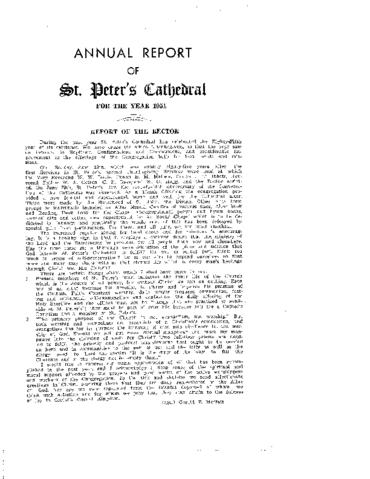Title and statement of responsibility area
Title proper
General material designation
- Textual record
Parallel title
Other title information
Title statements of responsibility
Title notes
Level of description
Repository
Reference code
Edition area
Edition statement
Edition statement of responsibility
Class of material specific details area
Statement of scale (cartographic)
Statement of projection (cartographic)
Statement of coordinates (cartographic)
Statement of scale (architectural)
Issuing jurisdiction and denomination (philatelic)
Dates of creation area
Date(s)
-
1954 (Creation)
- Creator
- St. Peter's Cathedral Church
Physical description area
Physical description
1 10 pp. printed annual report
Publisher's series area
Title proper of publisher's series
Parallel titles of publisher's series
Other title information of publisher's series
Statement of responsibility relating to publisher's series
Numbering within publisher's series
Note on publisher's series
Archival description area
Name of creator
Administrative history
As noted on the St. Peter's Cathedral Church website, the founding of St. Peter's was directly linked to a theological and liturgical revival of the Catholic tradition within Anglicanism, known as the Oxford or Tractarian Movement. This Movement began in England in the 1830's, and spread throughout the Anglican Communion worldwide. By the 1860's, some parishioners of the already long-established St. Paul's Church, in Charlottetown, had been exposed to the Oxford Movement through their travels, and wanted to erect a new church building where the teachings and liturgical observances of that movement could be reflected and practiced.
As noted in Wikipedia, St. Peter's, located on Rochford Square, corner of All Souls' Lane and Rochford Street, Charlottetown, was designated a cathedral in 1879 by Bishop Hibbert Binney, the Bishop of Nova Scotia. Over the years, it has served as a second cathedral of the Anglican Diocese of Nova Scotia (now called Nova Scotia and Prince Edward Island). (The principal cathedral of the diocese is All Saints' Cathedral in Halifax, Nova Scotia.) Attached to the west side of the cathedral is All Souls' Chapel, which was designated as a National Historic Site in 1990.
Land for the new church was made available by Mr. William Cundall, and construction began in 1867. By the spring of 1869, the building was completed, and Mr. Cundall then officially gave the land to the church on June 1, 1869. The opening services were held on June 13 of that year, but the Cathedral was not consecrated until the Feast of St. Peter, June 29, 1879. It was constructed in an area of the city known as West Bog. St. Peter's School was opened in 1872 the girls' school three years later. [[confirm when they closed]]
Following Oxford Movement traditions, choir members have worn surplices since the opening of the church. As early as 1872 the Rood Screen was erected and the seven hanging lamps placed in the sanctuary. The envelope system was adopted in 1876, and the pews have always been free. Altar candles have been used since 1877, and Eucharistic vestments since 1889. Originally, chairs were used at St. Peter's. In 1928, these were replaced by pews of dark walnut-coloured Douglas fir. The pulpit is the design of William Critchlow Harris, the brother of Robert Harris the artist, whose paintings beautify All Souls' Chapel. William Critchlow Harris was also the architect of All Souls' Chapel. The High Altar (complete with an Altar Stone) is still in its traditional position. Behind the Altar are statues of the Lord and four evangelists (Matthew, Mark, Luke, and John).
The first priest incumbent was Reverend George W. Hodgson, who served from 1869 to 1885. After Reverend Hodgson's death, Father Armstrong from Toronto and Father Smythe from the West Indies acted on an interim basis until Canon James Simpson was appointed the second Priest Incumbent in 1886 [[1887?]], serving until his death in 1920. A former master at Port Hope School, Canon Simpson had as his assistant the Reverend Thomas Henry Hunt. Canon Simpson, along with Mr. William Critchlow Harris (architect) and Mr. Robert Harris, C.M.G. (artist), were largely responsible for the creation of All Souls' Chapel.
Canon Elwyn Mortimer Malone, originally from Antigua, followed Canon Simpson, serving from 1921 to 1952. It was during his tenure of office that the property ceased to be vested in Trustees and was turned over to the Rector, Wardens, and Vestry.
In 1952 Canon Gerald E. Moffatt became Rector of the Cathedral, serving until 1958. Archdeacon J. R. Davies became Rector in 1958 and remained until 1967. Archdeacon G. S. Tanton, the second Islander to serve at St. Peter's after George Hodgson, became Rector in 1967, retiring in 1975. [[1974 or 1975?]]
In 1974, Canon H. M. D. Westin became the seventh Parish Priest and served until his retirement in October 1990. Aside from his spiritual and pastoral work as a dedicated priest, he is remembered for his founding of what is now the annual Atlantic Theological Conference, which continues to be held annually. To publish the proceedings of these conferences, St. Peter Publications was established in [[year]]. It publishes a book containing the papers presented at the previous year's theological conference, as well as "A Canadian Church Calendar", Common Prayer Commentaries, a Sunday School curriculum, and numerous books, pamphlets and tracts. For a number of years, St. Peter Publications also produced a quarterly periodical, The Anglican Free Press.
The next Rector, The Reverend Canon Peter Harris, from Nova Scotia, served for almost two years as Assistant Priest, starting in April 1989, before being appointed Rector at the end of 1990, continuing to the end of November 2014. The Reverend David Garrett succeeded Canon Harris as Rector in December 2014.
A new parish hall attached to the cathedral was erected in 2004, replacing an older hall that had stood on that site for over 100 years.
Custodial history
Scope and content
Annual report for 1954. There are handwritten notes on some pages.
Notes area
Physical condition
Immediate source of acquisition
Arrangement
Language of material
Script of material
Location of originals
Availability of other formats
A digital copy is available.
